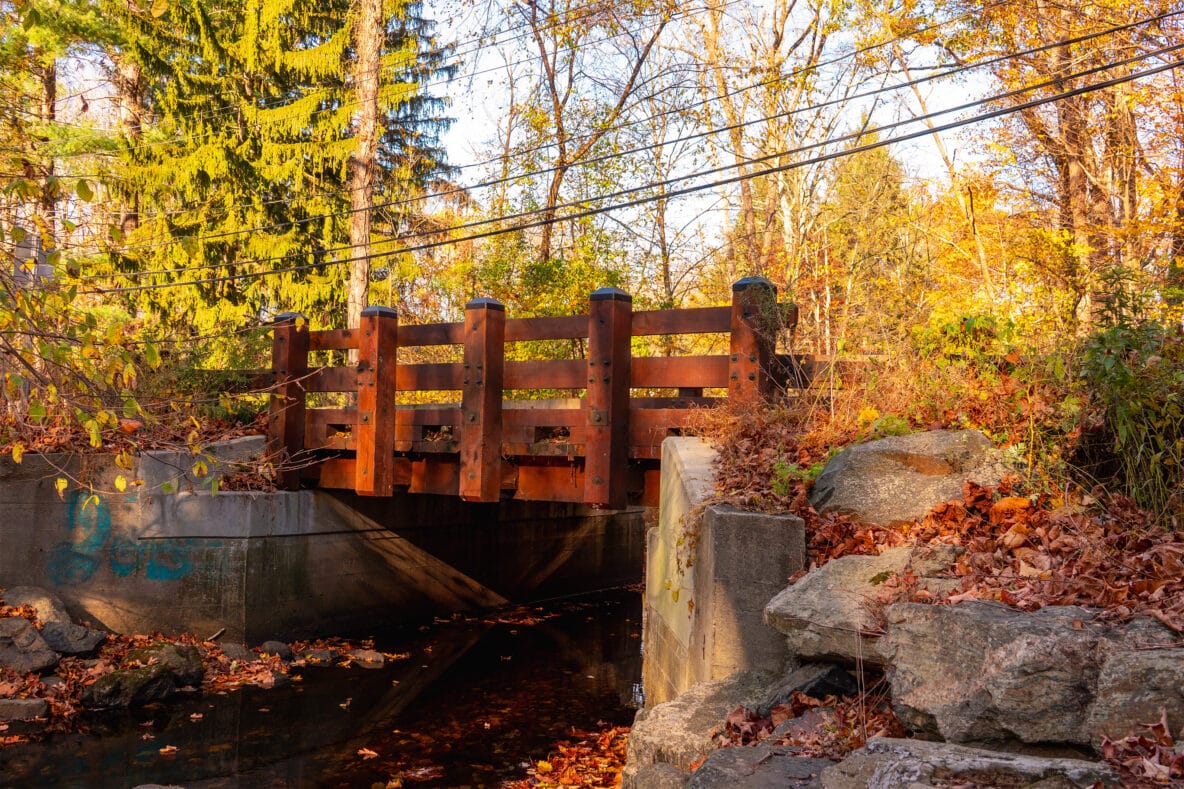An introduction to the Poverty Hollow HS20 timber vehicular project
York Bridge Concepts (YBC) stunning Poverty Hollow Bridge in Redding, Connecticut, an exemplar of modern timber bridge engineering. This HS20-44 rated timber vehicular bridge spans over a small waterfall, blending cutting-edge design with environmental stewardship. As an essential infrastructure piece on a local county road, the bridge plays a vital role in maintaining connectivity within the Redding community, which sees frequent traffic from commuters and residents alike.
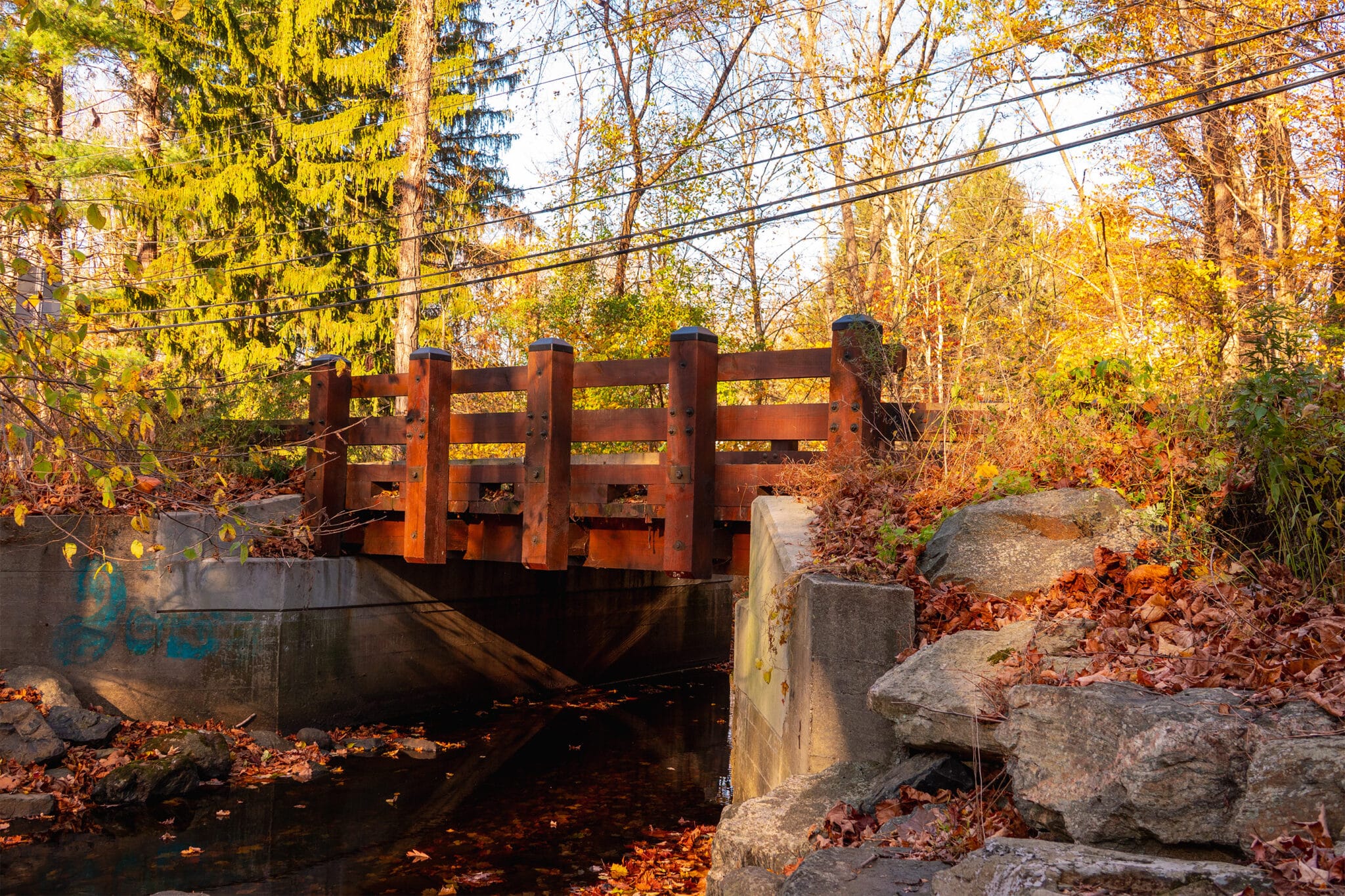
Specifications
- Vehicular Width:
- 20' (18' 5" clear)
- Vehicular Length:
- 27'
- Vehicular Height:
- 20' (from ground)
- Capacity:
- HS20-44
- Construction:
- Ground Level
- Span Type:
- Free Span
- Material:
- CCA/CA-C Treated SYP, Oil Coated where exposed. Epoxy Coated Decking
- Stringers:
SYP Glulam Stringers (Oil
Coated where exposed)- Vehicular Decking System:
Epoxy Coated Top Deck
4" SYP Subdeck- Guide Rail:
Decero™ Classic Design
Series- Crossing:
- Stream
The Poverty Hollow Bridge stands out for its free-span design, allowing it to stretch over natural obstacles without needing multiple support piers. This innovative design not only enhances the bridge’s durability but also ensures minimal disruption to the scenic environment around it, particularly the small waterfall it overlooks. The project is a prime example of YBC’s commitment to sustainable construction practices, using timber in a way that complements both the environment and the engineering demands of the structure.

York Bridge Concepts:
Pioneers in Timber Bridge Construction
York Bridge Concepts has long been at the forefront of timber bridge construction, known for their expertise in creating durable, sustainable, and visually striking structures. Founded on the principles of quality craftsmanship and environmental consciousness, YBC has built a reputation for constructing bridges that not only fulfill functional requirements but also harmonize with their surroundings.
We specializes in timber bridge construction, an approach that offers significant environmental and aesthetic benefits compared to conventional materials like steel and concrete. Timber, when sourced sustainably, is a renewable resource that leaves a smaller carbon footprint. YBC ensures that all the timber used in their projects comes from responsibly managed forests, aligning with their vision of sustainability. Their craftsmanship and attention to detail are evident in every project, including the Poverty Hollow Bridge.
YBC’s proven expertise in creating timber structures designed to last, even in challenging climates, made them the ideal choice for the Poverty Hollow Bridge project. Connecticut’s harsh winters demand materials and designs that can withstand snow, ice, and freezing temperatures, making the HS20-44 rated timber vehicular bridge a perfect fit for the location.
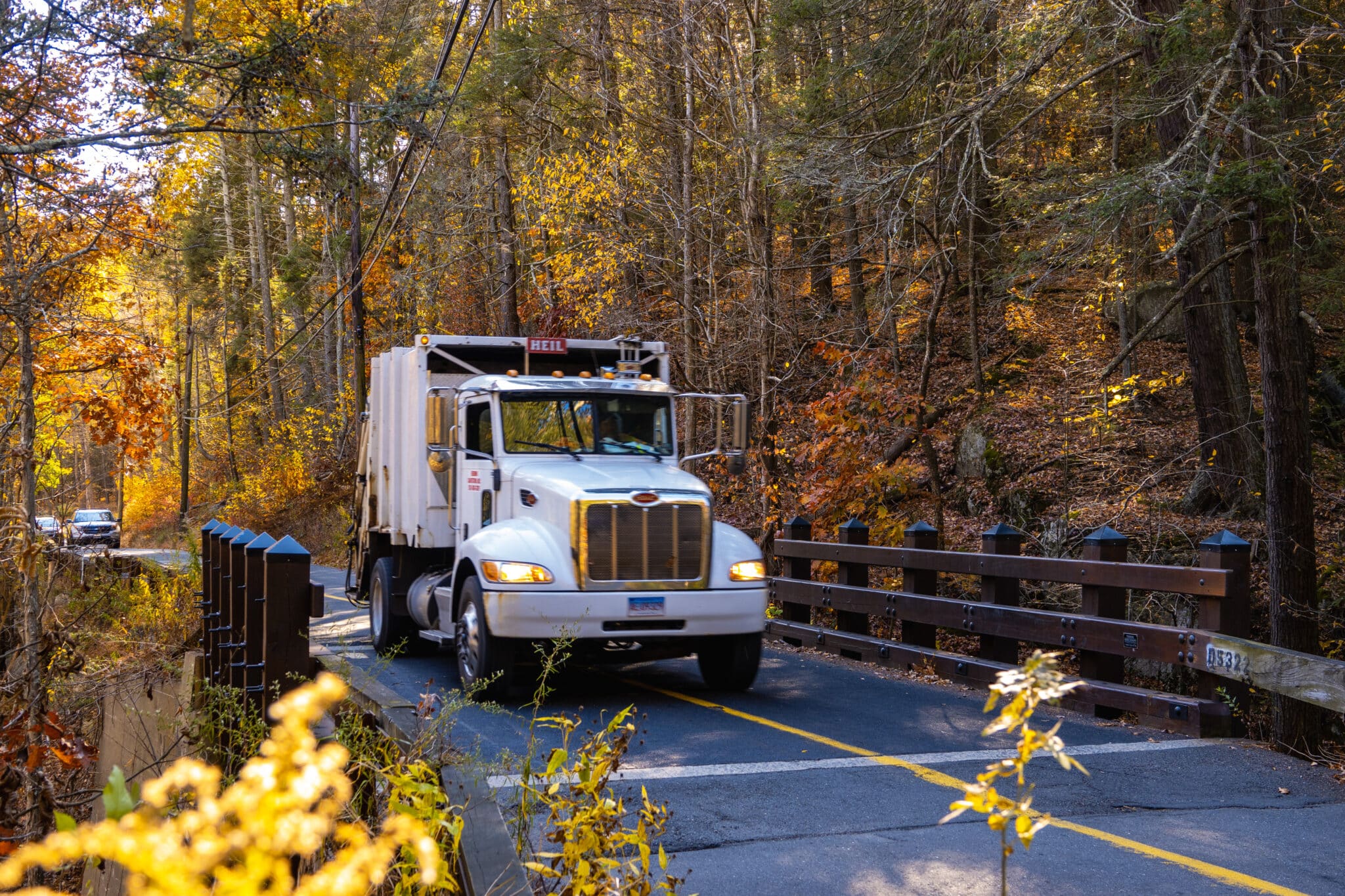
The Design of the Poverty Hollow Bridge
The design of the Poverty Hollow Bridge is a testament to both engineering excellence and environmental sensitivity. The bridge’s free-span structure is engineered to stretch across the small waterfall without interfering with the natural flow of water, thereby preserving the local ecosystem. Free-span bridges are ideal for crossing delicate environmental features as they require fewer supports in the water, which reduces the impact on aquatic life and water flow.
The Poverty Hollow Bridge adheres to the HS20-44 standard, which refers to the American Association of State Highway and Transportation Officials (AASHTO) load rating for vehicular bridges. This ensures that the bridge is capable of supporting heavy vehicles, such as trucks and emergency vehicles, making it robust enough for regular use on an active DOT road.
Sustainability was a major focus of the bridge’s design. YBC carefully selected timber species that offer natural durability, such as Douglas fir or pressure-treated southern yellow pine, which can withstand both the elements and the passage of time. Timber bridges like this one are engineered to resist moisture, freezing, and thawing cycles, ensuring longevity in regions like Connecticut where winter weather is particularly severe.
The decision to use timber as the primary construction material also enhances the aesthetic appeal of the bridge. Unlike steel or concrete, timber has a warm, natural appearance that blends seamlessly into rural or natural landscapes, making it a popular choice for projects in scenic areas like Poverty Hollow.
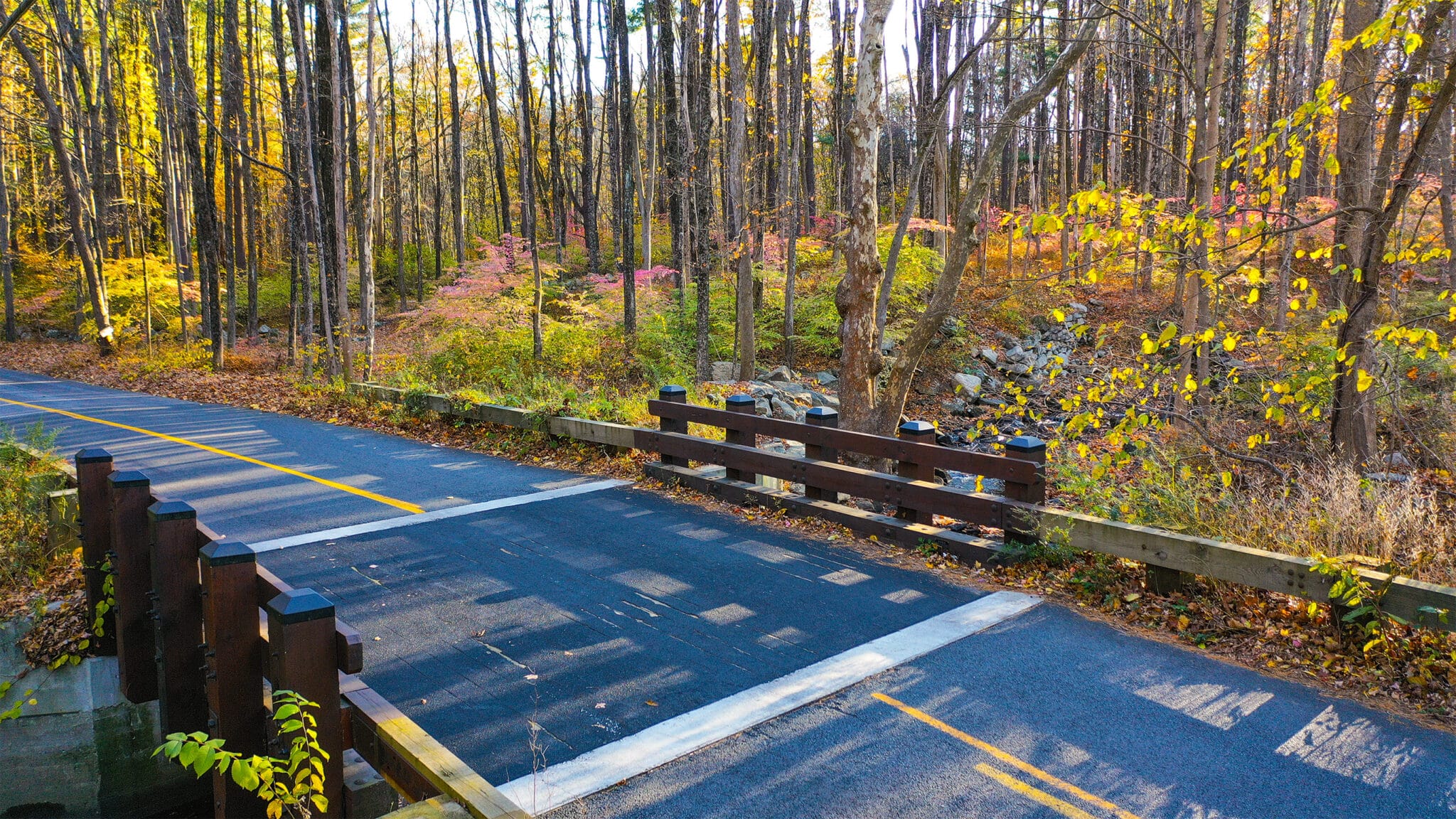
Sustainability in Timber Bridge Construction
YBC’s commitment to sustainability is one of the most significant aspects of the Poverty Hollow Bridge project. Timber, when sourced responsibly, is a renewable material that has a lower environmental impact compared to concrete or steel, which require more energy to produce and contribute to higher carbon emissions.
YBC works closely with suppliers to ensure that the timber used in their bridges comes from forests that practice sustainable harvesting. This means that for every tree harvested, multiple trees are planted in its place, ensuring the long-term health of the forest ecosystem. Additionally, timber bridges have a smaller carbon footprint over their lifespan. The energy required for processing and constructing a timber bridge is significantly lower than that of steel or concrete structures, making timber an ideal choice for those looking to build with the environment in mind.
In terms of durability, timber has been used in bridge construction for centuries and has proven to be long-lasting when properly treated and maintained. Advances in wood preservation and treatment techniques have allowed YBC to construct bridges that can endure harsh climates, resist rot, and remain structurally sound for decades. The Poverty Hollow Bridge exemplifies this approach, designed to thrive in Connecticut’s snowy, icy winters, and last well into the future.
The Role of the Poverty Hollow Bridge in the Community
Poverty Hollow Road holds significant importance in the Redding community, and the bridge that crosses over the small waterfall is a vital part of that infrastructure. The bridge not only enhances the local road network but also ensures that residents and visitors can traverse this picturesque area safely and efficiently.
Before the bridge’s construction, the road presented challenges for drivers, particularly in inclement weather. The new Poverty Hollow Bridge addresses these issues by providing a reliable, well-engineered structure that improves safety and ease of passage. Its ability to accommodate heavy vehicles while blending into the natural surroundings makes it an essential yet understated part of the community’s daily life.
As an active roadway, the bridge is used by local commuters, emergency services, and delivery vehicles, making it a critical component of the area’s transportation system. By constructing the bridge with durable, sustainable materials, YBC has ensured that the community will benefit from it for years to come.
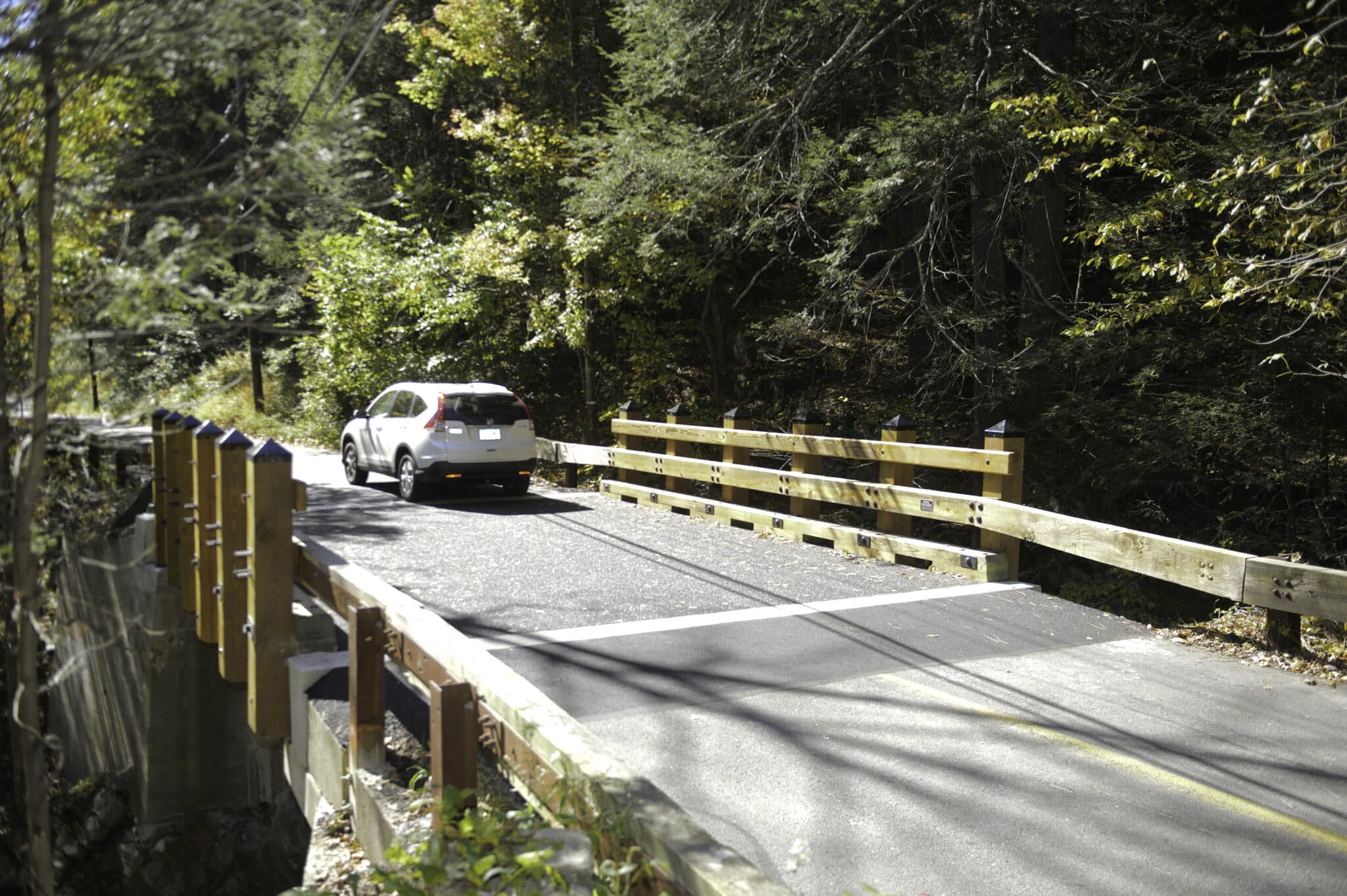
2012
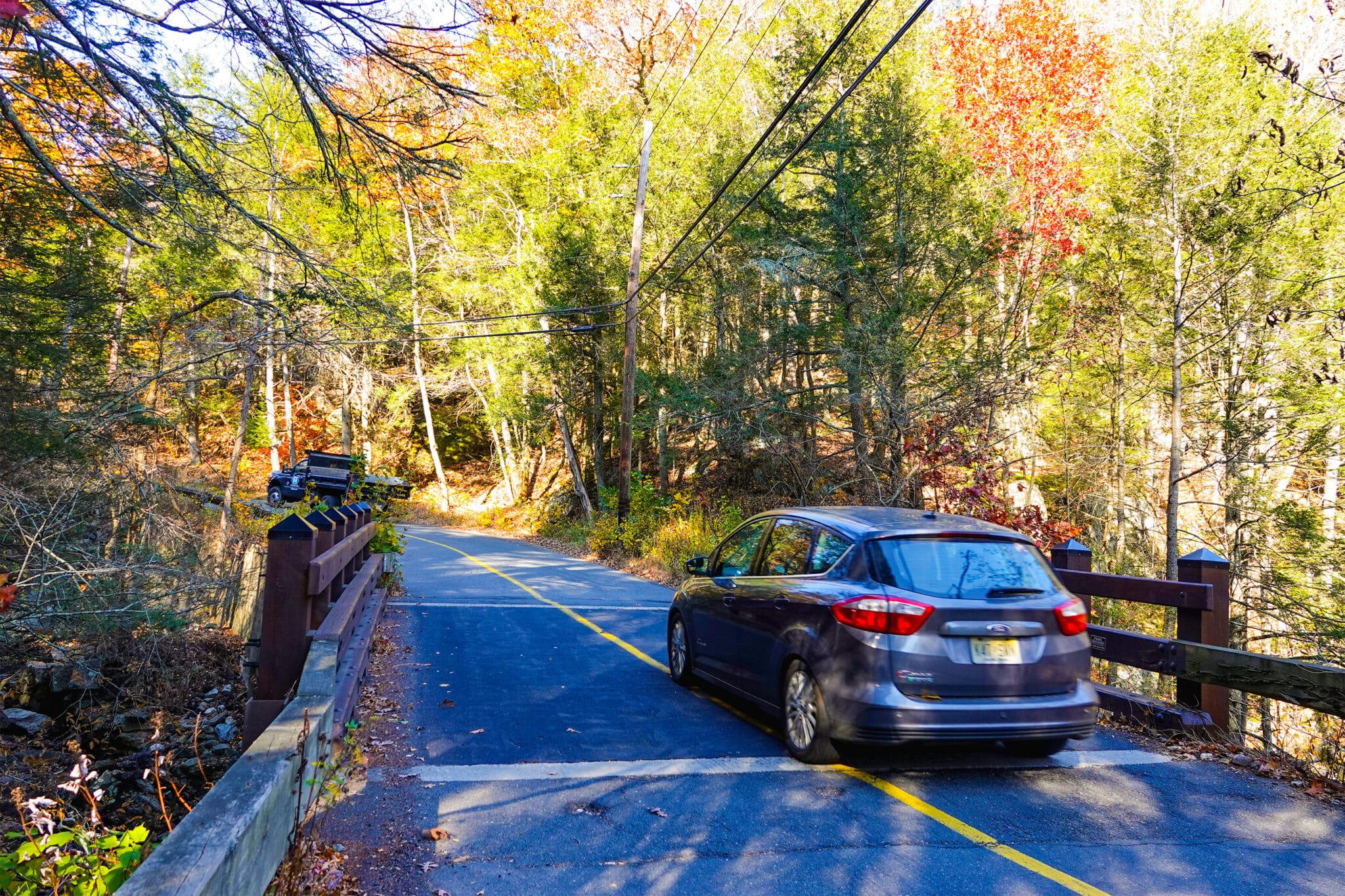
2024
Engineering for Harsh Winters: Addressing the Challenges
Connecticut’s winters are notoriously harsh, with heavy snowfall, ice, and freezing temperatures that can cause significant wear and tear on infrastructure. The Poverty Hollow Bridge was designed specifically to endure these challenging conditions. Timber, when treated properly, has excellent thermal properties, making it resistant to freezing and thawing cycles that can damage other materials.
The bridge’s free-span design plays a crucial role in its ability to handle winter conditions. Without piers in the water, there is less risk of ice accumulation causing structural issues. Additionally, the materials used in the bridge are treated to resist moisture absorption, preventing the expansion and contraction that can lead to cracks and other forms of damage over time.
Maintenance considerations were also a key part of the design. York Bridge Concepts regular inspects and manages upkeep of the Poverty Hollow bridge every 2-5 years. Additionally, YBC’s use of modern treatments and finishes has significantly reduced the maintenance burden, making this bridge a low-maintenance, high-durability solution for Redding’s infrastructure needs.

The Scenic Beauty and Functionality: A Bridge Over a Waterfall
The Poverty Hollow Bridge not only serves a functional purpose but also enhances the beauty of the surrounding landscape. The small waterfall over which it spans is a picturesque feature, and the use of timber in the bridge’s construction ensures that the structure complements, rather than detracts from, the natural scenery.
YBC’s design philosophy emphasizes harmony between the built environment and the natural world. The bridge’s understated elegance and natural materials make it an ideal fit for the rural charm of Poverty Hollow. Whether viewed from the road or from below by visitors to the area, the bridge enhances the aesthetic appeal of the landscape while serving as a critical piece of infrastructure.
Seamlessly Blending Sustainability, Engineering, & Aesthetic Appeal in Redding, CT
The Poverty Hollow Bridge project in Redding, CT, is a prime example of how York Bridge Concepts seamlessly blends sustainability, engineering excellence, and aesthetic appeal in their timber bridge designs. As a free-span, HS20-44 vehicular bridge, it serves an essential role in the community while respecting the environment it inhabits. Its ability to withstand the harsh winters of Connecticut and its sustainable design make it a model for future infrastructure projects that prioritize both functionality and environmental stewardship.
YBC’s expertise in timber bridge construction ensures that the Poverty Hollow Bridge will stand the test of time, providing safe passage for the Redding community for decades to come. With an eye toward the future, YBC continues to lead the industry in creating sustainable, durable bridges that enhance both infrastructure and natural landscapes.
Create Your Legacy Today
Discover the intersection of strength, durability, and environmental responsibility with York Bridge Concepts. Let's build a bridge to the future together.

